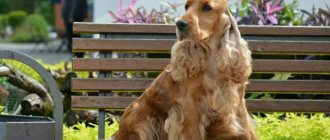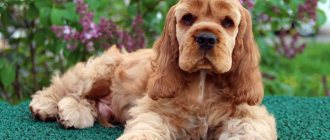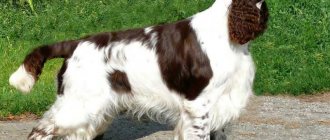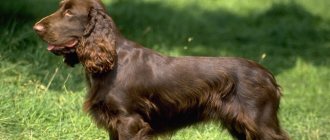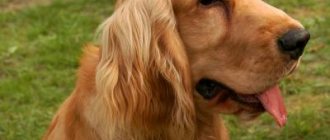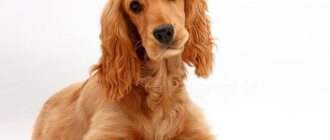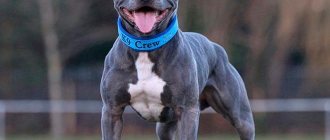At what age do you start training?
Puppy training must begin from the very first days
the presence of a dog in your home. Because already from infancy, the puppy must learn the rules of behavior in your house, what is allowed and what is forbidden, how to behave with all family members, even the smallest and oldest, what he can play with and what he can’t, where to go. toilet and much more.
And we are talking, first of all, about the proper upbringing of an American Cocker Spaniel puppy, and you can start training and learning commands when the puppy is completely comfortable in your home. As a rule, one week is enough. By this time, the puppy is already filled with curiosity and is diligently exploring the world around him. If, after this time, the puppy remains fearful and does not make contact well, then it is better to seek help from a dog handler-animal psychologist, because This behavior is not typical for puppies of this breed.
When can you start training with a dog handler?
The beginning of the puppy's training coincides with the time of the first exit to the street. When the first two vaccinations have already been done, the quarantine (lasts 7-14 days, depending on the vaccination) after them is over. It is not at all necessary to train your puppy only outside; the first sessions are best done at home, where there are fewer distractions.
Often new puppy owners worry that training from the first days will be excessively stressful for the dog. This is only possible if outdated, rigid methods are used, and with the right approach, training from the first days will, on the contrary, be very useful, since it allows you to immediately establish contact
with the puppy and build a trusting relationship.
You can start raising a puppy from the first days of its appearance in your home, and training and classes with a dog handler can begin simultaneously with the start of walks, when quarantine ends after the second vaccination.
Why you don't need to wait up to 6 months
You often hear that American Cocker Spaniels, like other dogs, cannot be trained before 6 months, because training is stressful. This opinion remains from the times of outdated methods based on cruel coercion and intimidation of the dog. Unfortunately, there are still plenty of dog handlers using similar techniques today. But fortunately, science does not stand still and modern techniques make it possible to train a puppy from the first days in a new home. Therefore, you should not wait until your American Cocker Spaniel puppy develops unwanted behavior; you can start training much earlier.
How to stop a spaniel puppy from chewing things correctly
was recognized as such in 1892, it was purposefully bred for hunting small game. During official existence
has been updated several times; the latest edition, approved in 1969, is currently in effect.
The English Cocker Spaniel is a small (up to 11 kg) dog, distinguished by its proportional build, long ears and expressive eyes. Cockers, for the most part, have a good character and know how to get along with children and pets. But, oddly enough, these seemingly “plush” dogs confidently hold first place among other breeds in the number of bites they inflict on their owners.
This breed, judging by reviews, is distinguished by courage, firmness and fortitude; its representatives often get involved in fights with much larger and stronger rivals and often win due to their tenacity. When raising a puppy of this breed, take this feature into account and do not let him “forget”, otherwise more than one of your hunts will be hopelessly ruined by dog fights.
Many people think that American Cocker Spaniels are a decorative breed, but this is not so. These may be the smallest in size, but they are hunting and detection dogs designed for hunting small game. All the working qualities of English cockers are fully inherent in American ones. This is an easy to train, versatile dog that can be both a pet and an excellent watchdog.
A dog living with people must be well trained and fulfill certain requirements.
Raising a spaniel begins with the simplest thing - teaching it to be handled. The puppy (and subsequently the adult dog) should allow himself to be calmly picked up, examined his teeth, ears, turned over, placed on the table and on the floor in a stand, and allowed to do with him whatever the owner considers necessary. You should accustom your puppy to such restraint from the first days of his arrival in the house. Believe me, this will make it easier for you to care for him in the future.
A dog’s behavior always depends not only on the innate qualities of its character, but also on the upbringing and special training received. A dog’s good response to commands and successful completion of tasks assigned to it are the result of regular training. A dog of any breed must be trained in general commands and obey its owner unquestioningly.
Raising a dog of a hunting breed implies that the owner carries out certain training programs with it that correspond to the age-related characteristics of the animal’s development. Of course, your goal should be not only to teach your spaniel commands, but also to raise a disciplined, easily controlled dog, which at the same time will become your true friend and will have all the qualities of a reliable and faithful hunting assistant.
Training is primarily about raising a dog.
The helpless and inept puppy that you bring into your home at the age of 1.5–2 months will have to go through a number of periods of physical and mental development before it can master all the hunting dog skills it needs. You must become a kind but demanding friend for your pet.
From the first day you should imagine what you would like your spaniel to be like in order to be able to clearly define all the further tasks that he will have to perform. Only then, focusing on this ideal, will you be able to systematically build your program for raising and training your pet.
As a rule, the entire period of development and formation of a dog is divided into several main stages, during each of which the animal acquires certain life experience. In the first weeks of life, the puppy's behavior is based mainly on the innate instincts that he inherited from his mother. Further, the formation of the dog’s character and habits will largely depend on you.
Your pet needs kind and sensitive treatment from all members of your family. But, as mentioned above, the strongest emotional and psychological connection is established between the dog and its owner. It depends on the owner’s attitude towards the dog how comfortable it will feel in the house.
Spaniels have a balanced and friendly character, which has a positive effect on the development of the working qualities of these animals. In addition, the skills that the dog acquires during training and systematic training are reinforced very well; all the owner’s commands are always carried out clearly and correctly.
Command “Come to me!”
The foundations for teaching a puppy the necessary commands are laid from the first days of his stay in the owner’s house. Young spaniels quickly master all commands, especially the “Place!” command. After the puppy masters it, start teaching him the “Come to me!” command. As you say it, tap the feeding bowl on the floor.
Remember that this command must be pronounced in a calm, quiet voice. Practice it while walking your pet, and be sure to reward the animal with treats and praise. If your pet performs the command sluggishly, without enthusiasm, repeat it again, but more sharply.
If you are training a dog on the street, keep in mind that it will often be distracted from training by external stimuli: cars, people, other dogs, unfamiliar smells, cats, etc. By paying attention to them, the animal may become confused. If this happens, entice him with a treat, and when the puppy approaches, pet him and release him.
Start teaching your puppy the “Come to me!” command. 5-10 minutes after we took him out for a walk. By this time he will have satisfied his natural needs and will want to play. To make the training as successful as possible, let the animal off the leash.
The leash on which a spaniel is trained is called a noose by dog breeders, and a ring leash by breeders. It is a flat cord with a loop at each end. One loop is put on the owner's hand, and the second is attached to the dog's neck. Such a leash helps the animal develop the necessary posture and promotes the learning process.
During training, never call the puppy to you in order to punish him or put on a collar, as this will develop an unwanted reflex in the baby. Every time you call your pet to you, he will assume that you are going to interrupt the walk and take him home. This will lead to the puppy refusing to obey the command “Come!”
We suggest you read: Choosing the right sand for chinchillas
Stand next to your pet and take a treat in your hand. Let your dog smell it and then pick it up so that it is out of your spaniel's reach.
Make sure you have your dog's attention and slowly take a step back, moving the treat from side to side. At the same time, say the command “Come to me!” several times.
When the spaniel approaches you, give him a treat and pet the dog. Take the spaniel that has followed the command by the collar and move it slightly to the side. Then treat him with a tasty morsel again. This will teach the dog that immediately after calling the owner takes it to another place.
Keep in mind that puppies are often disobedient between 5 and 8 months of age. They refuse to follow commands and can show aggression not only towards other pets, but also towards the owner. Try to remain patient throughout this period. If the puppy is in no hurry to comply with your command, accompany it with a loud clap of your hands or force your pet to sit by placing your palm on his croup and pressing lightly.
If the puppy, perfectly understanding the owner’s requirement, still refuses to carry out the command, do not punish him. However, such behavior should not be encouraged. Even if you simply ignore the animal’s disobedience and pretend that nothing happened, the puppy will decide that his behavior is completely acceptable, he will continue to refuse to follow commands, realizing that no punishment will follow.
The only correct way out of this situation is the following: pretend that you are no longer paying any attention to your pet and start moving in the opposite direction from him. Seeing that the owner is leaving, the puppy will run after him. When he approaches, don't scold him, because the spaniel will eventually obey your command. Give him a treat and cuddle him.
Remember that by teaching your pet to come to you on command, you will not only make your life easier, but also protect your pet from many accidents, which are often caused by the spaniel’s excessive curiosity and sociability.
Command "Aport!"
Training at 2 months. Upbringing
At 2 months old, your American Cocker Spaniel puppy is still at home, in quarantine after the first vaccinations, and he is not yet allowed to go for walks. Therefore, it’s time to start raising a puppy in the home conditions that are already familiar to him.
Toilet training
The first step is teaching the puppy to go to the toilet in a diaper . You should not rush to teach going to the toilet directly outside, bypassing this stage, because puppies are not physiologically ready for walking twice a day. This ability is developed in American Cocker Spaniel puppies no earlier than 6 months, and in some up to 1 year.
It should be remembered that any learning is a rather complex thing and, seeing the first positive results, you should not think that your puppy has already understood everything, but you should continue training according to the method, so that after a while you do not have to start all over again.
Collar and leash training
The second important point will be to accustom the puppy to a collar and leash . Yes, yes, this should be done at home, so that by the time the puppy goes outside for the first time, wearing a collar will not be additional stress for him, but is already a familiar thing, and he can start exploring the world around him, rather than trying to get rid of an unknown object.
What to allow a puppy and what not
The third point, which causes the greatest difficulty for new puppy owners, will be determining the puppy’s boundaries of what is permitted. Often, many novice dog owners think that the unwanted behavior of an American Cocker Spaniel puppy will “go away on its own, outgrow it.” But, unfortunately, the behavior that is allowed for a puppy will be taken for granted later by an adult dog.
.
Any unwanted behavior in a puppy WILL NOT go away on its own, but will only become stronger over time.
Therefore, it is necessary to start defining the puppy’s boundaries of what is permitted now. You will need:
- Teach to play only with your toys, and not with your things;
- Explain that you cannot bite your hands even in a game;
- Establish the correct daily routine, establishing the rule that in the morning you need to sleep and not wake you up;
- Stop chewing furniture, clothes, walls and baseboards;
- Teach to stay home alone, knowing that your absence is not a reason to bark or howl.
IT IS EXTREMELY IMPORTANT TO KNOW: constant and excessive punishments that follow almost every action of the puppy have a detrimental effect on his fragile psyche and can lead to the fact that the American Cocker Spaniel puppy grows up cowardly and embittered. For normal natural development, a puppy must have the opportunity to explore the world around him, which is currently limited to your apartment or house.
Introduction to Basic Commands
Already now you should begin to familiarize yourself with the initial obedience commands in a light playful form, while focusing on rewards for execution, because the puppy’s psyche is still quite plastic and excessive severity and exactingness can lead to the puppy being intimidated and cowardly. Therefore, it is necessary, first of all, to try to interest the puppy by offering him a toy or treat, and sometimes just praise.
How to stop a puppy from chewing things incorrectly
First, let's understand where such wrong advice is most often given?
It’s clear that they are given on different forums, because you don’t know exactly how experienced the person who writes there is. Some breed “experts” advise to wean a puppy from chewing furniture. Very often you can come across the following advice from “experts” - “look at which piece of furniture the puppy is chewing, and rub the place where the puppy reaches with pepper or mustard.” In fact, the advice is effective, a puppy, having tried such an object on its teeth, will be horrified by the taste and will stop gnawing on the object, but think about whether such advice is worth implementing. Imagine that all receptors in dogs are much, tens of times more sensitive than human receptors. Moreover, this applies not only to the sense of smell, but also to taste buds.
https://www.youtube.com/watch?v=83_kXVkjgTY
Think about what is more important to you: the safety of your furniture or the health of your pet? We think the answer to this question is obvious. Treatment of such an injury can subsequently take a lot of effort, time and money from you, and it is not a fact that the consequences will pass without a trace. In addition to damage to the taste buds, the spaniel puppy (photo) may also receive respiratory injuries.
It is this organ that is capable of giving the dog comprehensive information about the subject that the puppy is interested in. Have you ever smelled peppers or onions? Remember these terrible sensations, and now imagine that the puppy smells ten times stronger. As a result, such upbringing can lead to serious problems for the dog; it may subsequently lose its sense of smell or even die.
There are some “experts” who advise physically punishing a puppy for his pranks or simply hitting him. This is also a very effective method, but instead of a well-mannered dog, you end up with a downtrodden and frightened pet who will be afraid of you like fire. This will not add obedience to him; on the contrary, the spaniel puppy, growing up, will become embittered; in some sources, there is even evidence that after such upbringing, puppies, and subsequently adult dogs, even took revenge on their owners.
No, don’t think that a puppy or an adult spaniel will gnaw your throat at night, this, of course, won’t happen, but shitting in your slippers or chewing on your favorite thing is quite possible. What to do, the dog cannot protect itself otherwise. Over time, your dog will become a downtrodden and very unhappy animal; the puppy’s appetite may deteriorate, which will subsequently lead to disorder in the pet’s health.
First of all, be patient; if you notice that your spaniel puppy has begun to chew on your things, then you can simply scold him for this. These dogs are incredibly smart, so even a simple conversation with your puppy can lead to a positive outcome. There is no need to yell at the puppy, just scold him for what he did.
He may be teething, he may be doing it out of boredom, and so on. Therefore, firstly, provide your puppy with your attention, try to fill all his free time with communication with you, and secondly, provide the puppy with all the necessary toys, so that if he is idle, he can always chew on his favorite rubber bunny or run after a rubber ball.
The third way to stop a puppy from chewing everything is to learn the “fu” command, and an ordinary rolled-up newspaper will help you with this. If the puppy begins to play around and chew your slipper or furniture, simply spank him with a newspaper and at the same time say the command loudly and clearly. The newspaper will not harm the puppy, but will simply frighten the puppy with the rustling sound.
The English Cocker Spaniel really needs the attention of its owner. The owners never have any significant problems interacting with this breed; the dogs quickly adapt to the lifestyle, habits of the owner, as well as to the new home. Raising a Cocker Spaniel puppy should begin as soon as the baby crosses the threshold of his new home.
The sooner the owner starts training his pet, the more obedient the dog will be subsequently and the fewer problems the owner will have with training. While the dog’s psyche has not yet been formed, its behavior can be easily modeled by teaching the dog respect and proper attitude towards the owner. You should not expect your dog to learn the necessary rules instinctively.
The only exceptions may be the rules of cohabitation. For example, a cocker spaniel can adapt to the owner’s schedule and time that is convenient for him. The Cocker Spaniel is very affectionate, both with close family members and complete strangers. That is why the main thing in raising a dog is to teach it not to be distracted by every passerby, fervently sniffing random people it meets and jumping on children playing in the yard.
This behavior can cause discomfort to strangers, but first of all, it can be dangerous for the animal itself. Dogs of this breed are distinguished by their intelligence, so the skills that the owner teaches the dog remain with him until the end of his life. Raising a Cocker Spaniel puppy should be a combination of affection and persistence.
When answering the question of how to train a cocker spaniel, you can play an exciting game to interest the dog. Due to the gullibility of cocker spaniels, the owner must first teach the dog basic commands and accustom him to a leash and collar. The commands “come to me”, “place”, “sit” must be learned by the dog as soon as possible, even if you plan to sell the cocker spaniel.
With the help of these commands, the owner can easily control the actions of his dog. In order for the puppy to learn the “come to me” command, you need to lure the puppy during a walk, and when he runs up, reward him with a treat. A command worked out several times will be learned by the dog, and after a certain amount of training, the command will be forever etched in the dog’s memory.
Training a Cocker Spaniel puppy includes learning to walk on a leash and to be comfortable with a collar. If, after putting the collar on the dog, he tries to take it off, you need to distract the puppy by offering him an exciting game. If the dog cannot get used to the collar for a long time, you need to make sure that it is suitable.
A collar that is too tight can damage the spaniel's delicate coat and skin. When the dog gets used to the collar and learns to walk on a leash, you can teach him the command “near” for this too, you can use the reward method. Show the puppy a treat, and then invite him to walk near your leg. You should not pull the leash toward yourself, as this will only irritate your cocker spaniel.
To explain to the dog what actions are not acceptable, you need to use emotional intonations. You cannot, under any pretext, raise your hand to a spaniel; the puppy will be very offended by you, and besides, you can injure him. Training a cocker spaniel at home involves detailed memorization of the commands “lie down”, “sit” and some others, albeit not very important, but very cute, such as “give me a paw”.
Find a trainer for your Cocker Spaniel
Training is the development in a dog of certain skills necessary to control its behavior. At the same time, the owner encourages the dog with his signals (commands and gestures) to perform (or not perform) certain actions: sitting, laying down, presenting an object, guarding an object, returning to its place, etc.
We invite you to familiarize yourself with: Anubias bartera nana (dwarf): keeping in an aquarium, flowering, reproduction, photo
It is best to start obedience training when the puppy reaches the age of 4 months. At this time, he is most receptive to training and tries to please his owner.
If the owner does not start training the dog before it is a year old, then in the future his pet will become completely uncontrollable, and it will be very difficult to get rid of the bad habits he has acquired.
Of course, you can train a dog at any age, but the later the owner begins to do this, the more difficult it will be for him to succeed.
It is best to start training when the puppy is 4 months old.
Not only the trainer, but also the dog is an active participant in the training process. The success of training as a whole depends on both participants, whose mutual interests are always combined with mutual responsibilities. Dogs react sensitively to an individual “cocktail” of human odors, intonation and timbre of voice, clothing and gait, behavior at home and on the street.
General training is the basis for the subsequent preparation of a dog for one or another special service, since most of the skills developed during general training are the basis for mastering special training skills.
Training at 3 months. Socialization
Three months is an important stage in introducing an American Cocker Spaniel puppy to the outside world. Your first walks should be short and not too tiring for the puppy. You should start with 15 minutes, gradually increasing the walking time to 1 hour.
Correct formation of the nervous system
At this age, the puppy’s nervous system is forming.
. It has been proven that raising puppies in isolation during this important period contributed to the development of pronounced cowardice in them later. It is necessary to show the puppy as much as possible: noisy streets, large crowds of people, etc. Everything that he will have to face in later life.
This must be done very carefully, gradually, over and over again increasing the time spent in noisy places, so as not to overload the puppy or frighten him.
The territory of a country house, cottage or village are places with a minimum amount of external stimuli for a city dog. Therefore, if you plan to keep a dog in an urban environment, “growing up” an American Cocker Spaniel puppy in such conditions depleted of irritants is unacceptable.
A city puppy must grow up in the city, in conditions that are saturated with external stimuli, such as: noisy streets, large crowds of people, other animals, birds, cyclists, cars, etc.
Meeting people and dogs
It is necessary to introduce the puppy to friendly dogs and people
so that later the puppy does not develop aggression or cowardice caused by the fear of new things and the inability to communicate and make new acquaintances. Currently, unfortunately, this is not uncommon in the behavior of adult dogs, but a fairly common problem with which people turn to our specialists for help.
Puppy behavior on the street
The emergence of new places leads to new rules that need to be consolidated:
- Now you can and should go to the toilet on the street, and not stoically endure it, carrying everything home;
- Not every new person or dog wants to communicate, so you don’t need to run headlong to meet everyone;
- Not all food is healthy, so it should only be taken from the owner’s hands.
Training and practicing commands
Training a puppy follows the same principles as at 2 months. It should be remembered that at this age puppies develop conditioned reflexes quite easily, but they are forgotten just as quickly, so you should not scold the puppy for not following commands, especially if they have not been repeated for a long time, but you should pay more attention to learning new things and repeating already covered material .
Training at 4 - 5 months
By this time, the American Cocker Spaniel puppy has already become accustomed to your home and usual walking areas, and no longer needs your support and care so much. He begins to flirt with other dogs, pretend that he does not hear you when you call him, and show a certain persistence and disobedience when performing various commands.
This means it's time to move on to full training . In classes at this age you can already be persistent and demanding. At the same time, the most important thing is not to overdo it, remember that classes should bring joy to both you and your dog, and only then you can achieve the desired result.
Required commands in 4 months
What commands are practiced by an American Cocker Spaniel puppy at 4 months:
- Calm movement next
to the owner with and without a leash, with landing when stopping, with a change in pace and direction of movement - Return to you
upon request - Staying
in a free or certain position (sitting, lying, standing) for a long time: if necessary, wait for the owner on the street, when visiting a store or other establishment - Indifferent attitude towards treats scattered on the ground
- Inhibitory command
to stop unwanted actions - Execution of a set of commands “sit”, “lie down”, “stand”
at a distance and near the leg, when giving commands by voice and gestures - Stop barking
on demand.
Training and raising a dog
You need to train a dog to make it a real hunter immediately after purchasing it and getting used to its name. First, the animal is accustomed to simple commands - “sit, lie down, no, come to me.” If training is carried out too harshly, not in the form of a game, the dog will lose interest in it.
Hunting teams can begin to be vaccinated at 4 months. For each correctly completed instruction, they give a dog treat (not sweets!) . Later they begin to work in the field using a collar and leash. You can also take your puppy into the forest with already trained dogs. In general, such dogs learn quickly thanks to their lively mind and excellent memory. With the right approach, there will be no problems with them both at home and on the hunt!
Training from 6 months
At this age, the puppy begins puberty and the real rebel awakens in him. He begins to re-test the boundaries of what is permitted and, sometimes, deliberately does not respond to your commands, only in order to look at your reaction. If she is not what the puppy expects to see, then he may decide that now he can no longer carry out your commands.
Remember that a puppy is still a child.
, and excessive harshness can forever undermine his trust in you.
At this stage of growing up an American Cocker Spaniel puppy in training, all the shortcomings made at the previous stages, which were smoothed out by his young age, become clearly visible. And if they appear, it’s time to correct them.
In many training schools, there is an opinion that a puppy needs to be trained in two stages, the first at an early age, and the second at 8 - 10 months, in order to “consolidate” what has been learned. This is not an entirely correct position; this opinion appeared when newer operant training methods began to be added to the old “DOSAAF” rigid training methods, where they began to work with the puppy strictly after 6-7 months, including working with the method of pointing and following the “target”.
Their weakness was that they were two different techniques.
, which began to be used without adapting to each other, having a huge gap between their tools for developing training skills. The difference between them is like between choreography lessons in kindergarten and army drill training. Therefore, they required training in two stages, which were in no way connected with each other.
Modern methods based on zoopsychology make it possible to train a puppy in a single system , when no additional stages of training are required.
Buying a dog
According to statistics, only 50% of hunting dog owners conduct home training (general obedience) with their pets; others cannot do this either due to lack of time or inexperience. No more than 20–25% of owners can provide their dog with field training, field coaching and training.
The owner of a spaniel must remember that when training it is necessary to take into account the character of the dog, since it is as multifaceted as the character of a person. To achieve success in training, the owner must carefully and thoughtfully approach the education of the dog, and carefully look at the pet’s behavioral characteristics.
Experienced dog breeders recommend keeping a dog training diary. Significant facts from the dog’s life and the results of observations of your pet are recorded in a notebook or notebook. This will help determine whether the dog has the reflexes necessary for hunting. You will also be able to understand the reasons for the mistakes you made during training, and judge the results that you and your dog achieved through long and hard work.
Reading your diary later, you will see how step by step you learned to understand the dog, how you gradually developed hunting qualities in it, without intimidating or causing feelings of bitterness in your pet. When making entries in the diary, the owner should note all the features of the past day: the presence of strangers, distracting noises, objects, smells, the dog’s health and much more that in one way or another influenced the upbringing and development of your spaniel.
A hunting dog has a particularly pronounced pursuit instinct.
The instinct of pursuit as an unconditioned reflex is deeply embedded in the genes of an animal and, in essence, determines the entire complex of its behavior. Undoubtedly, it is associated with the process of obtaining food, and for a male dog also with the pursuit of a female. From the very first days of his work, a novice trainer will have to reckon with the instinct of pursuit and escape, which is especially pronounced in hunting dogs.
Many hunters complain that young dogs who go out searching for the first time do not pay any attention to the game, but chase sparrows, butterflies, and dragonflies. Some try to explain this by the dog’s lack of sense, others by the fact that the dog “hasn’t had time yet.” But the real reason is that the owner failed to focus the young dog’s attention on a specific object, and it is driven by the natural instinct of chasing everything that runs away and flies away.
You should introduce your dog to the specific smell and appearance of partridge while still at home. Be sure to connect the search for it by smell with taste rewards and certain signals, that is, establish a conditioned reflex to search for the partridge. Then your spaniel will be able to select the one he needs from a thousand smells and hundreds of moving objects and focus all his attention on it.
Before setting out with your dog to hunt for snipes for the first time, it is recommended that you bring home a killed bird and introduce your young student to the look and smell of game. In the field, you must hide the killed great snipe in advance somewhere under a hummock in the meadow. Then, with a certain signal, which was previously established in the dog’s conditioned search reflex, you force it to look for hidden game using the method in which it was trained (wide search with a shuttle).
We invite you to read: Features and specifics of feeding large breed puppies
The dog begins the search and, following the instructions of your hand, makes several runs to the right and left until it finally smells a familiar scent. Having caught the exact direction, she naturally pulls you straight towards the great snipe, runs up to it and stops over the hummock. Now you need to use another signal, previously learned by the dog, to make him stop and wait (make a stand).
The owner must train the dog to search for game during the hunt only after his command
This method has been well tested and is fully justified when training hunting dogs. Along the way, the owner can develop conditioned reflexes in the dog through signals and teach it to behave correctly with game in advance. For example, to ensure that a spaniel remains standing after a shot and does not grab a fallen bird, you can train him as follows.
Killed or still alive, with its wings tied, the snipe is placed on the ground somewhere behind a tree. Your assistant should climb the tree, holding in his hands a rope with a snipe tied at its end. After the search, when the spaniel smells the game, approaches it and, at the signal you give, makes a stance, you, stopping a few steps behind, fire a shot at the snipe, which was quickly raised on a rope by your assistant and immediately thrown to the ground.
Your shot is a signal for the dog to “Down!”, but a bird falling on the ground in front of it can cause the dog to jump up and try to rush forward. At this moment you give the command “Lie down!” If the dog obediently lies down, you reward it with a treat; if it hesitates, you repeat the command “Lie down!” over and over again. Any well-trained dog will learn this eventually.
Dog training
It often happens that a poorly trained or overly active dog rushes forward towards the game without any caution and spooks it before the hunter can shoot. To avoid this, you need to teach the dog to do the so-called reaching, that is, to walk slowly, carefully, so as not to frighten the game and allow the hunter to approach it at a very close distance.
Of course, you can use painful techniques and, with the help of a curl, force the dog to restrain its forward movement. But, as mentioned above, violence brings nothing but harm and only makes training more difficult.
Experts suggest the following method of training a dog.
With the help of a noise signal (Galton whistle), which is very convenient when hunting hard game, and the taste reward associated with this sound stimulus, you develop conditioned reflexes in the dog to move forward with interruptions: on one signal it takes several steps forward, on another signal – stops.
Good contact with the dog and concentration are extremely important both during training and during the hunt itself. The combination of quick orientation in a given area and the ability to immediately notice signs of game or an animal, the ability to instantly prepare for a shot, along with maintaining constant contact with the dog will make the hunting process enjoyable and successful.
Galton's whistle
A dog, especially a hunting dog, has hearing that is incomparably more subtle than a person. In the huge arsenal of human technical inventions there is a whistle, designed by the physicist Galton, the sound of which is not always heard by the human ear, but is heard by a dog.
Portability is one of the positive qualities of the Galton whistle. You can make it sound if necessary without removing it from your pocket: the sound is played by just pressing your palm on your pocket. For game, this sound will be one of the many noises filling the forest and field. Training based on the establishment of conditioned reflexes using this sound alarm is very simple and effective.
If you are serious about your Spaniel's hunting training process, you may want to invite a professional to test your dog's preparation for hunting. During the test, such hunting qualities of spaniels as flair, stretching and retrieving, speed, persistence and correctness of search, walking style, ability to present game, and obedience are identified and evaluated.
Smell is the spaniel’s ability to find a bird by smell using its sense of smell.
The correctness of the search is the method of shuttle ahead of the hunter with a distance to the right and left of up to 30 m.
Search speed - the speed and ease of movement of the spaniel.
Leading is the dog's transition to faster movements towards the bird.
Stretching is the slowing down of the spaniel at the moment when he smells the bird.
The style of movement is energy, beauty of movement and search.
Presenting killed game: this skill is regarded as one of the most important elements in the work of a hunting dog.
Perseverance and obedience – the spaniel’s unfailing, clear and quick execution of the hunter’s commands and signals. To determine the dog's attitude to the shot, the hunter must fire the first shot with a blank cartridge, and then shoot the bird with the second shot.
After assessing the dog's search for birds, the spaniel must be tested for presentation, using a freshly killed bird for this purpose. The dog is tested to retrieve game from land and water.
Testing of purebred dogs is necessary in order to select for breeding animals that have full-fledged behavioral reactions and meet the requirements of the standard; identify and prevent dogs with obvious mental and behavioral abnormalities (cowardice and aggressiveness) from being used for breeding.
This test is not a replacement for dog training courses known in Russia; it is designed to assess the dog’s natural behavioral reactions. Successful passing of the test provides the dog with permission for breeding use. Testing is carried out by a commission of experienced breed specialists, which includes an expert or instructor on working qualities and an RKF expert on this breed.
The commission authorized to evaluate dogs according to this test must meet at least once a quarter so that everyone can have their dog tested at a time convenient for them.
Dogs over 12 months of age are allowed to take the test.
The owner of the dog is required to present the original pedigree to the commission. Dogs born in 1997 and younger must have a brand.
Assessments can be: positive (T1 and T2) and negative.
Our dog handlers
American Cocker Spaniel training specialists
Alexander Chaplygin Dog psychologist-zoopsychologist
Experience: 37 years Read more..
Ekaterina Panova Dog psychologist-zoopsychologist
Experience: 34 years Read more..
Yaroslav Morozov Dog psychologist-zoopsychologist
Experience: 25 years Read more..
Lada Yurtseva Dog psychologist-zoopsychologist
Experience: 21 years Read more..
Victoria Fox Dog psychologist-animal psychologist
Experience: 14 years Read more..
Ekaterina Budkina Dog psychologist-zoopsychologist
Experience: 13 years Read more..
Evgeniy Bravinsky Dog psychologist-zoopsychologist
Experience: 17 years Read more..
Vitalia Bravinskaya Dog psychologist-zoopsychologist
Experience: 10 years Read more..
Kira Ageeva Dog psychologist-zoopsychologist
Experience: 19 years Read more..
Evgenia Zuber Dog psychologist-zoopsychologist
Experience: 12 years Read more..
Tatyana Melnikova Dog psychologist-zoopsychologist
Experience: 10 years Read more..
Alexey Melikhov Dog psychologist-zoopsychologist
Experience: 22 years Read more..
* Check with the managers for the possibility of a specific specialist visiting the area you specified. If the desired dog handler does not work in your area, then we can offer you another specialist from the above.
Training an American Cocker Spaniel puppy in
When you turn to our dog training center for help in training an American Cocker Spaniel puppy, you can be sure that a real specialist in his field
and will provide training at the proper, highest level.
- A dog trainer will come to your
home at a time convenient for you. - Classes are held 1-2 times a week
, depending on the program. - Instructors work from 9:00 to 21:00
, on weekends inclusive - The training program is drawn up at the first lesson,
taking into account the breed, age, personal characteristics of the dog and your wishes for training - Some classes take place at home
, some
outside
, depending on the topic of the lesson. - Puppy age
from 2 months
Our Center employs dog handlers - animal psychologists who have experience in working with American Cocker Spaniel puppies and training adult dogs from 10 to 35 years old, who know all the nuances of their behavior
and features of training at each stage of a dog’s growth. Therefore, your pet is guaranteed to learn to carry out your commands the first time in any conditions, and will become your faithful and reliable companion.
